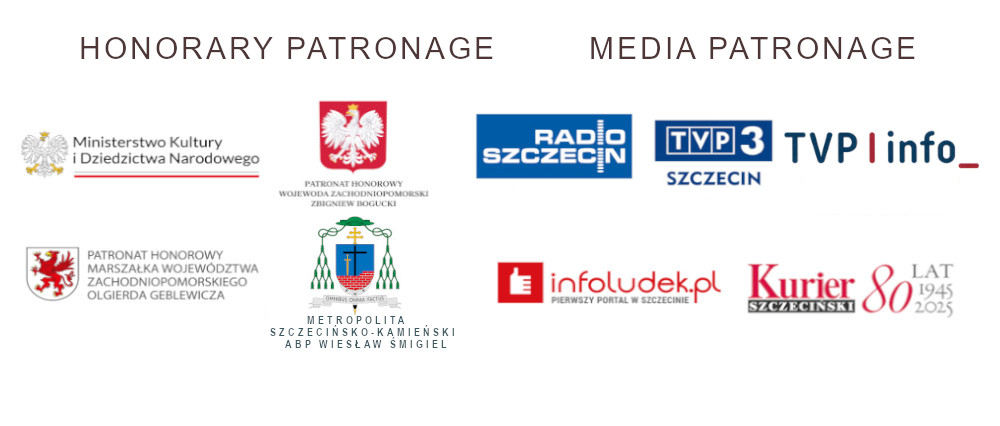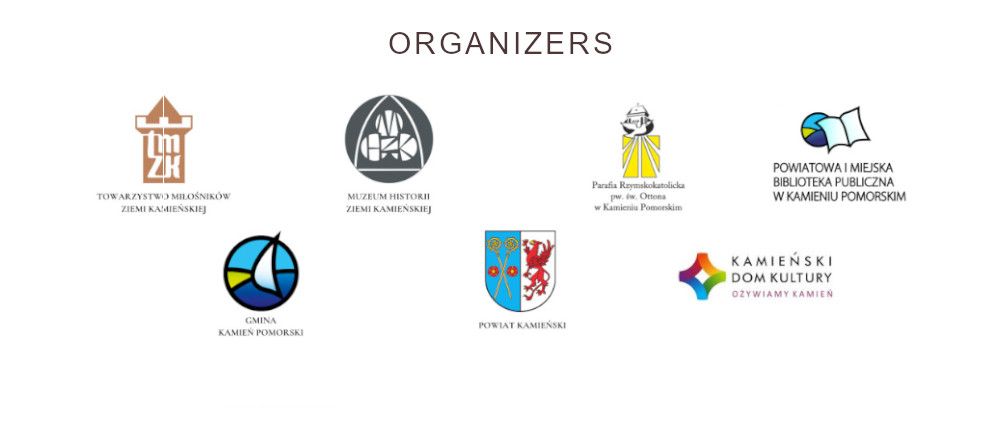About the organ
The voices of the organ of the Cathedral in Kamień Pomorski are arranged:
HAUPTWERK:
(13 STIMMEN)
- Quintadena 16’
- Gedact 8’
- Prinzipal 8’
- Spillpfeife 8’
- Octave 4’
- Hohlflöte 4’
- Quinte 2 2/3’
- Octave 2’
- Rohrflöte 4’
- Rauschquinte 2f
- Mixtur 6-8f
- Trompette 8’
- Clairon 4’
RÜCKPOSITIV:
(9 STIMMEN)
- Quintadena 8’
- Gedackt 8’
- Gedacktflöte 4’
- Prinzipal 4’
- Octave 2’
- Quinte 1 1/3’
- Sesquialtera 2f
- Scharff 4-5f
- Krummhorn 8’ Tremulant
OBERWERK:
(12 STIMMEN)
- Koppelflöte 8’
- Prinzipal 8’
- Gemshorn 4’
- Octave 4’
- Blockflöte 2’
- Nasat 2 2/3’
- Terz 1 3/5’
- Scharff 4-6f
- Zimbel 3f
- Dulzian 16’
- Bärpfeife 8’
- Schalmey 4’
- Tremulant
PEDAL:
(10 STIMMEN)
- Prinzipalbas 16’
- Subbas 16’
- Quintbas 10 2/3’
- Rohrflötenbas 8’
- Octavbas 8’
- Nachthorn 2’
- Octave 4’
- Mixtur 4f
- Posaune 16’
- Trompette 8’
- Zymbelstern
Source: Mariusz Stankiewicz, Baroque Organs in Kamień Pomorski (2014 Kamień Pomorski, ISBN 987-83-939085-0-9)
History of the Organs of the Kamień Co-Cathedral
The oldest organs of the Kamień church could have been built before 1400. In his extensive treatise on the Duchy of Pomerania, Heinrich Berghaus cited a note from August 24, 1433, informing that in times past the chapter maintained an organist who used to play on the organ built for the glory of God on individual holidays.
In 1308, a fire broke out in the cathedral, which almost completely consumed it. During the reconstruction and expansion of the church, which took a long time, since the goldsmithing work did not begin until the turn of the 14th and 15th centuries, the first organs of Kamień were probably built. When in December 1534, based on the decisions of the Sejm in Trzebiatów, the Evangelical Bishop Bartholomäus Suave took over the Kamień Cathedral from the last Roman Catholic bishop Erasmus Manteuffel, he found the royal instrument in a state requiring at least a general renovation.
The old organs were to serve the first Evangelical organist Johannes Stielkoven and his successor until 1580, when the decision was made to build a larger and more magnificent instrument. After long discussions and disputes, it was decided to entrust this task to the organ workshop of the local craftsman Adrian Zickermann, who came from an old and well-known family of organ builders. He built an impressive instrument with 60 registers in the cathedral. Due to the lack of constant, systematic maintenance and necessary ongoing repairs, after only 17 years, a major renovation was necessary in the years 1594-1597, during which the new choir was strengthened. These procedures lasted for thirty years. In 1628, the intention was made to carry out another general renovation, this time related to changing the layout and replacing the pipes. However, this renovation was not carried out due to a large fire, which on June 4, 1630 partially consumed the tower and seriously damaged the organ. Finally, in 1669, funds were found for the construction of a new organ, as further renovation of the old instrument proved completely unprofitable.
We, by the grace of God, Ernest Bogusław, Duke of Croy and Arechot, Prince of the Holy Roman Empire, Margrave of Havre, Count and Lord of Fontenoy, Bayonne and Domp Martin, as well as of Nowogard and Maszewo, Privy Councilor of His Electoral Highness the Lord of Brandenburg, Governor of the Duchy of Prussia, Pomerania and the Duchy of Kamień, and the Cathedral Priest in Kamień […] decided that we would have a new organ built at our expense for the cathedral in Kamień […] the organ builder has already volunteered to carry out this work […] therefore, work is to begin in the Name of God. The funds intended to cover the costs of construction and the materials were part of the sum that Ernest Bogusław received from the Great Elector Friedrich Wilhelm for renouncing the title of Duke and Bishop of Kamień in his favor. The thrifty prince, in a letter to the cathedral organ trustee Walenty Winter, on November 6, 1669, pointed out that a significant part of the organ pipes were in very good condition (163) and should be reused. On November 15 of that year, the prince sent a solemn memorandum to the cathedral prelates, informing them of the decision to build a new organ. Much indicates that the chosen constructor was Friedrich Breyer, the author of two versions of the proposed instrument arrangement. For unknown reasons, however, he resigned from the entrusted task, and negotiations began with the builder of the organ in St. Mary's Church in Stralsund, Michael Berigel. However, a formal agreement was not concluded with him until 1670.
The new organ was built over the course of two years. The instrument, completed in 1672, was accepted on 29-30 November by the famous organ builder Balthasar Heldt. The instrument test was very successful. The organ was 13 metres wide, 9 metres high and had a total of 2,660 pipes. The letter of commendation dated 16 December 1672 stated: After a magnificent sermon, the Te Deum Laudamus was played […] then the organ was played in all voices […] nothing needed to be corrected […] The excellent builder […] was commended for such a famous work. Based on the decision of the Chapter Council, he received a salary of four thousand thalers. However, the acceptance of the instrument did not mean the final completion of work on the organ. An entire cartload of wood was used to build the organ case, and in 1682-1683 the Stargard painter Johann Schmidt, together with a team of collaborators, carried out the necessary painting and goldsmithing work on the casing. The prince allocated 335 thalers to pay the contractors for the finishing work on the organ, which was completed over 36 weeks, which had to be enough to buy gold, paints, curtains and current, minor repairs.
When accepting M. Berigel's new instrument, the organ builder Balthasar Heldt probably did not check the stability of the casing's foundation. It took as many as ten years before it was deemed necessary to make construction corrections to its attachment. On 19 November 1683, an agreement was concluded with a journeyman builder who was to eliminate the structural defects and ensure that the organ stood firmly. The effect of the undertaken efforts turned out to be such that already in 1696, only thirteen years after the structural corrections had been made, it became necessary to commission the execution of a new organ substructure from master Philipp Treikel. The results of his work were verified relatively quickly. On May 15, 1726, the organ builders Heldt and Richter stated that the positive required new support. This problem returned like a boomerang, because thirteen years later B. Heldt raised it again.
During the first general renovation of the new instrument in the years 1787-1837, new supports were made. However, they did not fulfill their task, since they were dismantled shortly afterwards during subsequent work to strengthen the structure of the instrument itself and its casing.
In 1800, the care of the Kamień instrument was taken over by the Szczecin organ building company Grüneberg, founded in 1782. Georg Friedrich Grüneberg rebuilt the instrument, partially changing the specificity of its sound and finally eliminating the problem of the stability of its foundation. In 1820, he once again modified the arrangement of the organ stops, changing a further part of the registers. In the mid-19th century, the conservation care of the Kamień instrument was taken over by another Szczecin organ building company, F.C. Kaltschmidt. During the first renovation, it did not introduce any significant changes to the instrument's arrangement. They were to take place only in 1888, when the Kamień organ no longer resembled the Baroque instrument built by Michael Berigel. This was due to Barnim Grüneberg and his team of associates. Barnim, the son and successor of August Wilhelm, captivated by the spirit of Romanticism and fascinated by the organ music of Ferenc Liszt, Felix Mendelssohn Bartholdy and Max Reger, radically changed the disposition of the royal instrument, rebuilding it into a 44-voice Romantic organ with electro-pneumatic windchests, new groups of voices and modern solutions for the mechanics of recording. In its new sound, the organ survived until World War II. During the war in 1941, it once again found itself in the hands of the renovation team of Feliks Grüneberg, whose company had already been moved from Szczecin to nearby Zdroje (Finkenwalde). Feliks decided to restore the Kamień instrument to its former, baroque sound shape, and thus to the arrangement intended by Fryderyk Breyer and later Michael Berigel. The substantive supervision of the renovation team was entrusted to the outstanding organ builder Rudolf von Beckerath from Hamburg. Unfortunately, the seriously advanced work was not completed. In 1945, the instrument was plundered and largely destroyed. The most serious deficiencies concerned the case pipes. The instrument was restored to a usable state by Kurt Berendt, an organ builder from Wałcz. In July 1964, work on the Kamień organ began with the company of Zygmunt Kamiński's organ builder from Warsaw. The substantive supervision of the scope and quality of the work was assumed by the Organ Department of the State Higher School of Music in Kraków. In 1965, for the first time after a quarter of a century of silence, the organs of the Kamień Cathedral sounded as an almost fully concert instrument, but requiring further renovation work. The organs were far from their former glory. As the distinguished expert in historical organs, Marian Dorawa, stated: The only and right solution should be a reconstruction aimed at recreating the original Berigel instrument, both from the structural and technical side, as well as the acoustic and musical side.
In 1992, Zygmunt Kamiński submitted an offer for a thorough reconstruction of the Kamień organ. 80 percent of the wooden and metal pipes, as well as the playing table and windchests, were to be replaced or repaired. However, this work was not carried out at that time. The further history of renovation and construction work on the co-cathedral organs is connected with the Władysław Cepka Organ Construction and Reconstruction Plant from Popowo near Wronki, which took over the instrument in 2001 and provided care for it to this day. The priority of the work undertaken was to "preserve the original sound set and aesthetic concept of the organ", which was adopted during its re-baroque by Feliks Grüneberg's plant before 1945. The work program was based on a reconstruction plan developed by Prof. Julian Gembalski and the arrangements made during working meetings held by the performer Władysław Cepka, the host of the cathedral and the parish priest of Kamień, Rev. Canon Dariusz Żarkowski, and Prof. Józef Serafin, the artistic director of the festival.
Despite the long-awaited renovation, subsequent editions of the festival took place without disruption. The main part of the renovation began in 2003. The work was carried out by the organ builder Władysław Cepka under the supervision of Prof. Gembalski. During the work, among other things, some of the pipes were replaced and a new playing counter was installed. The old one went to the Museum of the History of the Kamień Land.
After the completion of renovation works during the jubilee, fortieth edition of the Kamień festival in 2004, the organs sounded in their full glory.
Everything indicates that in the 21st century the last will of Prince Ernest Bogusław de Croy will continue to be respected: We wish ourselves […] that God Almighty would deign to preserve the new organ until the end of the world and that the organs would be played by a skilled organist.
Dr Mikołaj Szczęsny
Władysław Lupa, a long-time organist, talks about the magnificent Kamień organs:
Source: Virtual Heritage Foundation

 DE
DE  PL
PL  EN
EN 



